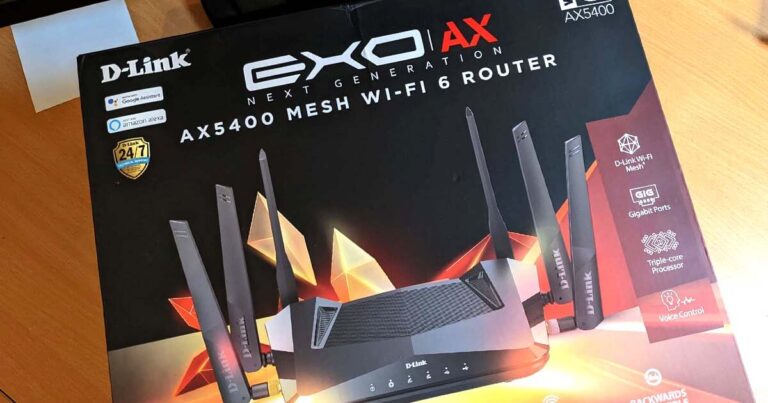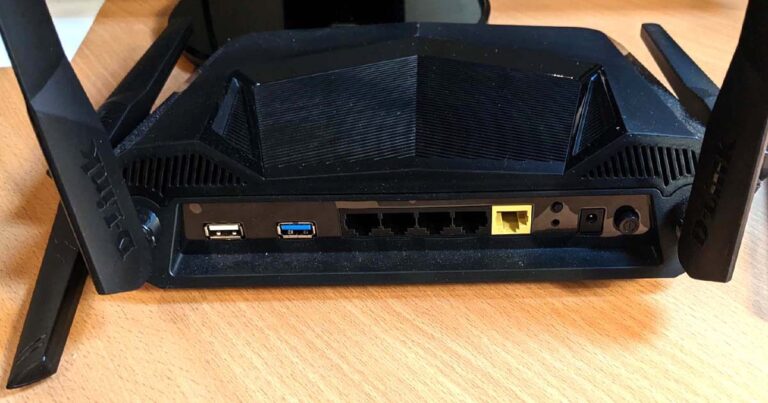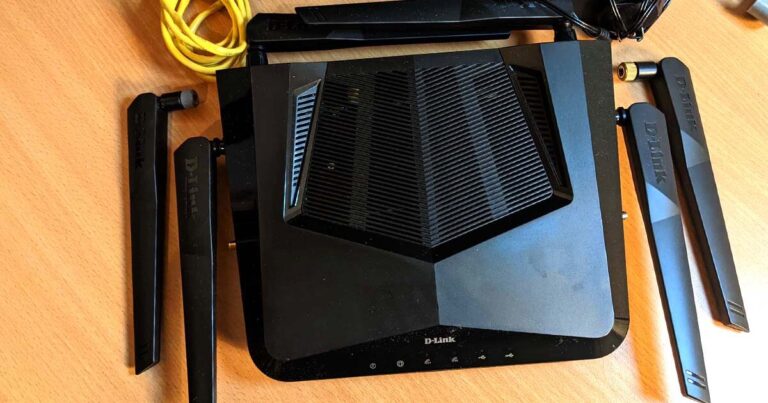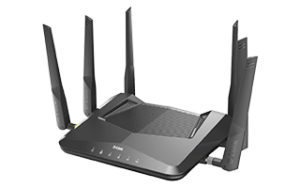The D-Link DIR-X5460 router takes simplified mesh logic and puts it inside a very user-friendly router.
D-Link EXO AX AX5400 (DIR-X5460) review
As WiFi 6 devices start to become more commonplace, it’s easy to see why people are curious about upgrading their networking equipment to experience the advantages over WiFi 5. While you can spend an arm and a leg on top-of-the-line WiFi 6 routers like the Synology RT6600ax, the D-Link DIR-5460 has more reasonable pricing for an easy-to-use router.

D-Link X5460 price and value for money
After balking at the eye-watering price for the admittedly fully featured Synology RT6600ax, it’s nice to test a mid-tier-priced WiFi 6 router ($399RRP) that impresses in the right areas. The cheapest WiFi 6 routers cost around $200, but doubling that price gets you into higher-performance territory. Anything beyond $400RRP is for gaming-specific routers, mesh WiFi systems and top-of-the-line future-proofed networking gear. At the time of writing, it was possible to nab the D-Link DIR-5460 for around $300, which boosts the overall value.
D-Link DIR-5460 setup and configuration
The D-Link DIR-5460 looks like some sort of Imperial spaceship design from Star Wars, so it’s not going to win any awards for subtlety. But D-Link doesn’t mess around when it comes to configuration simplicity, which starts with a well-packaged product and a practical quick-start guide.
Screw on the two unattached antennas, then fold them upwards with the other four that are already screwed into place. It’s tricky to get the rest wrong, with a power cable and a single yellow Ethernet cable that’s meant for the yellow WAN port (the other end goes into your modem). Still, we wish the power adaptor was in a vertical orientation rather than old-school sideways, which can make placement a pain on a power board.
The other gripe I have with the installation is the QR code on the quick installation guide leads to a user manual rather than the D-Link WiFi app. Admittedly, the app is easy to find in the Google Play Store or App Store, and it offers step-by-step guided installation. Even manual installation without the app is a breeze, more so if you’re with an NBN provider that’s listed in the configuration drop-down menu.
Superloop is my current provider, and while it wasn’t listed, manual configuration was as simple as selecting ‘Other’ from the provider list, then selecting the IPoE network protocol instead of PPPoE (read our NBN network protocol guide for more info). Basically, if your provider isn’t listed, try PPPoE if you have a username and password from your provider, or the DHCP option if you don’t.
While not as handhold-y as the app steps, the D-Link DIR-5460 installation wizard providers simple installation guidance. The only thing that may weird you out (which it did me), is the installation wizard only asks for a single wireless network name (SSID), despite the typical two for 2.4GHz and 5GHGz. But that turns out to be a fantastic asset.

What is D-Link?
D-Link DIR-5460 speeds and performance
When I was only prompted to enter a name and password for one WiFi network, I went digging into the D-Link DIR-5460’s settings to see what I missed. The first thing I noticed was the simplicity of the D-Link DIR-5460’s operating system. It separates items into logical main categories, which you hover over for drop-down options. Basically, it encourages exploration and experimentation without overwhelming the user.
As for that second WiFi network, it doesn’t exist, unless you want to add a guest network. This may sound like a con, but it’s actually a big pro because D-Link has taken a leaf out of the book of mesh WiFi systems and folded the farther-reaching 2.4GHz band and speedier 5GHz band into a single wireless network. This means you don’t have to add multiple wireless networks to your devices for at-home use, and it also means the DIR-5460 intuitively switches between 2.4GHz and 5GHz bands based on how far away your devices are from the router.
In terms of speeds, the D-Link DIR-5460 offers impressive results. I ran tests with my Superloop NBN 100/40 connection (which uses Fibre-to-the-Curb technology) during the busy evening hours and scored the results below (note that bigger numbers are better for download and upload, but lower numbers are better for latency):
For comparison, here are the speed results for the Synology RT6600ax WiFi 6e router.
And here are some speed results for the Netgear Nighthawk XR700 WiFi 5 router.
While my apartment isn’t particularly big, it’s great for testing WiFi signals thanks to the router placement, which is behind an LG C7 OLED TV. This particular 4K TV has a metal stand which, admittedly, should only impact the bottom “WiFi TV” results. Meanwhile, all other tests have to at least pass through the TV screen and most have to contend with at least one 13cm-thick concrete wall.
The important part to pay attention to are the respective changes to latency, download speed and upload speed. The lower the impact, the better the router is at handling WiFi range and tackling interference. While the D-Link DIR-5460 dominated the upload speed comparisons (only losing out by a breath in one test), it also took some promising range wins for download and had the best latency for one of the test locations through a thick concrete wall.
Overall, these speeds are solid for the different types of interference the D-Link DIR-5460 is handling.
D-Link DIR-5460 versatility
One of the most annoying features of the D-Link DIR-5460 operating system is it logs you out after a very short idle time. It’s hard to complain about this security-first approach, though, and it’s even more impressive that you’re prompted to enter your own admin password during setup to avoid the handful of default passwords that are bad for router security.
D-Link clearly wants to encourage its users to tinker, which is great. The basic connectivity options are under Settings, but the Features drop-down menu is where you’ll find the advanced functionality. Quality of Service (QoS) is a standard feature for routers these days, but the D-Link DIR-5460 makes it even easier with a straightforward speed test as well as a drag-and-drop system for prioritising device bandwidth across highest, high and medium categories.
There are other features you might want to tinker with here, too—including port forwarding, a firewall and a website filter—but I also really like that it includes router-level virtual private network (VPN) support, even if it’s more complicated to configure than the other features. What’s infinitely more straightforward is the automated firmware updates, plus the peace of mind that the router stores backups in case an automated update goes wrong.
The other advanced feature everyday users should tinker with is the USB functionality. Connect a USB hard drive, and within a few clicks, you can activate a media server (accessible to the entire network) as well as Windows file sharing or even an FTP server.
Is the D-Link DIR-5460 router worth buying?
If you can nab the D-Link DIR-5460 for the $100-cheaper-than-RRP prices that were floating around at the time of review, it’s absolutely worth buying. Even at full price, the D-Link DIR-5460 pushes out a strong WiFi 6 signal that tackles range and interference well. The user-friendly design that carries over from setup to encouraged tinkering is equally impressive.

How we review routers
We test our routers in ways that are meaningful to everyday users. That starts with looking at where the price of a router falls in comparison to its peers, relative to the features it offers. Then comes the setup, evaluated in terms of hardware installation and initial configuration to get connected.
We like a router that’s easy to install, simple to configure and one that’s easy to tinker with for users who like to personalise settings inside a router’s operating system. Ultimately, though, a router has to offer a speedy and reliable network—mainly for preserving internet speeds but also for local transfers—which is why we pay close attention to the results of our speed tests.
From there, we test a router as an everyday device. While high-end, future-proofed bells and whistles are great, we like routers that reliably work in the background to make it easy to browse the web, play games, share files locally and, ideally, offer wide-reaching WiFi networks.
Frequently asked questions about D-Link routers
Related Articles






